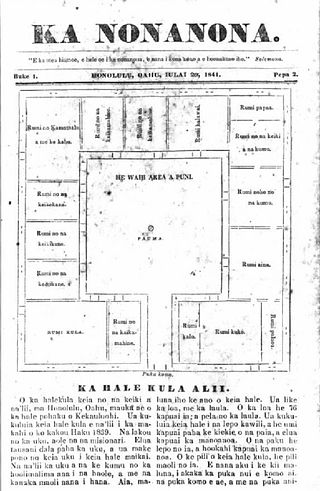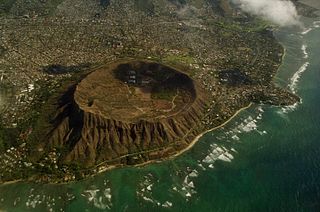
Salt Lake is a neighborhood of Honolulu, Hawaii on the island of O‘ahu. The area is also known as Āliamanu after a nearby crater, although Salt Lake itself is in a crater called Ālia pa‘akai — meaning "salt pond" in the Hawaiian language. The Salt Lake community was developed in the 1960s during a construction boom, providing residents with an expansive view of downtown Honolulu and the sugarcane plantations of the central plain of O‘ahu. It is a community of high-rise condominiums, mid-rise town-dwellings, and houses snaking around the remnants of a now freshwater lake.

Charles Reed Bishop was an American businessman, politician, and philanthropist in Hawaii. Born in Glens Falls, New York, he sailed to Hawaii in 1846 at the age of 24, and made his home there, marrying into the royal family of the kingdom. He served several monarchs in appointed positions in the kingdom, before its overthrow in 1893 by Americans from the United States and organization as the Territory of Hawaii.

Moanalua is a valley, a stream, an ahupuaʻa, and a residential neighborhood in Honolulu, Hawaiʻi. The valley extends inland from behind Āliapaʻakai crater to the crest of the Koʻolau Range.

The Royal School is a historic school founded in 1839 in Honolulu, Hawaiʻi, as the Chiefs' Children's School. The school was renamed as the Royal School in 1846. After the boarding closed in 1850, it became a day school for children. It later became a public elementary school, and moved to its present campus in 1967.

Kaimukī is a residential neighborhood in Honolulu, Hawaii, United States.

Kalihi is a neighborhood of Honolulu on the island of Oʻahu in Hawaiʻi, United States. Split by the Likelike Highway, it is flanked by downtown Honolulu to the east and Mapunapuna, Moanalua and Salt Lake to the west.

The Melchers Building is a historic commercial building in Downtown Honolulu, Hawaii. Located at 51 Merchant Street, it is the oldest commercial building in Honolulu. Designed in the Classical Revival style by an unknown architect, it was constructed in 1854 of white coral blocks. The original structure's qualities are no longer visible beneath outer layers of stucco and paint.
Kumu Kahua Theatre is a community theater located in the city of Honolulu on the island of Oahu in the state of Hawaii. Kumu Kahua Theatre is best known for producing plays by local Hawaii-based playwrights, especially plays featuring themes and stories of the people of Hawaii. Therefore, actors are often featured utilizing their natural local dialect or respective ethnic accent, and many plays have incorporated or are solely written in Hawaiian Creole English, an English dialect commonly known in the Hawaiian islands as pidgin. Their productions are also known for involving local actors, designers, directors, and theater technicians. Appropriately the Hawaiian language words kumu kahua translate to "original stage." People familiar with the theatre often call it affectionately by its nickname of Kumu.

Thomas Charles Byde Rooke was an English physician who married into the royal family of the Kingdom of Hawaii. He built a mansion called the Rooke House in Honolulu that became popular with political and social leaders of the Kingdom.

Japanese Consulate-General, Honolulu is Japan's diplomatic facility in the City and County of Honolulu, Hawaii, United States. The facility is located at 1742 Nuuanu Avenue. The facility's jurisdiction includes Hawaii and American Samoa.

Pearl Harbor is an American lagoon harbor on the island of Oahu, Hawaii, west of Honolulu. It was often visited by the Naval fleet of the United States, before it was acquired from the Hawaiian Kingdom by the U.S. with the signing of the Reciprocity Treaty of 1875. Much of the harbor and surrounding lands are now a United States Navy deep-water naval base. It is also the headquarters of the United States Pacific Fleet. The U.S. government first obtained exclusive use of the inlet and the right to maintain a repair and coaling station for ships here in 1887. The surprise attack by the Imperial Japanese Navy on December 7, 1941, led the United States to declare war on the Empire of Japan, making the attack on Pearl Harbor the immediate cause of the United States' entry into World War II.

Dwight Baldwin was an American Christian missionary and medical doctor on Maui, one of the Hawaiian Islands, during the Kingdom of Hawaii. He was patriarch of a family that founded some of the largest businesses in the islands.

Kinoʻoleoliliha Pitman, also written as Kinoole-o-Liliha, was a high chiefess in the Kingdom of Hawaii. She was known as Mrs. Pitman after her marriage. In the Hawaiian language, kino 'ole means "thin" and liliha can mean "heartsick".

The Oʻahu Cemetery is the resting place of many notable early residents of the Honolulu area. They range from missionaries and politicians to sports pioneers and philosophers. Over time it was expanded to become an area known as the Nuʻuanu Cemetery.

Fort Kamehameha was a United States Army military base that was the site of several coastal artillery batteries to defend Pearl Harbor starting in 1907 in Honolulu, Hawaii.

Samuel Northrup Castle was a businessman and politician in the Kingdom of Hawaii.

The Chinatown Historic District is a neighborhood of Honolulu, Hawaii, known for its Chinese American community. It is one of the oldest Chinatowns in the United States.

Samuel Mills Damon was a businessman and politician in the Kingdom of Hawaii, through the Republic of Hawaii and into the Territory of Hawaii.

The Boston Seaman's Friend Society or Seafarer's Friend is a charitable religious organization based in Boston, Massachusetts. It aims to improve the welfare of mariners.

Samuel Chenery Damon was a missionary to Hawaii, pastor of the Seamen's Bethel Church, chaplain of the Honolulu American Seamen's Friend Society and editor of the monthly newspaper The Friend.



















